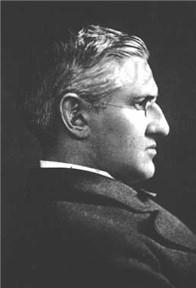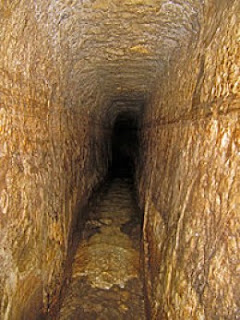The Basilica San Darwin is one location in the UK I have been familiar with since I was a boy. Equally majestic in its interior structure as St Paul's Cathedral, Southwark Cathedral, il Basilica San Pietro, Westminster Cathedral, or even Westminster Abbey, I ask you which of the six basilicas is the odd one out?
Why, it's il Basilica San Pietro, of course! It's at Vatican City in Rome. The other five are all in London.
Indeed, I can classify the Basilica San Darwin, aka the Museum of Natural History, as a religious building, as its imposing Central Gallery, now known as the Hintze Hall, resembling the interior of a cathedral, with stained glass windows at the far end that's characteristic of any large Christian church, and even surrounded by cloisters. On the landing above a flight of stairs stands a white statue of Charles Darwin sitting rather alone and dwarfed to miniaturisation by the immense structure built in his name.
 |
| Hintze Hall, Natural History Museum, Stock photo. |
The exhibits dominating the Central Hall had changed at least twice since my first visit as a boy (at first with my parents and then with the class of our primary school.) Back then, if my memory hadn't fazed, I recall a circular platform in front of a dominating skeleton of a Diplodocus, on which stood two lifesize elephants on one side, and two rhinos on the other, also lifesize. Then, afterwards, these mammals were moved elsewhere, and the plaster-cast skeleton held dominance, symbolising the entire museum until 2017, when the skeleton was dismantled to begin a tour of the UK, to be replaced by the real bones of Hope, a young Blue Whale.
Talking of primary school children, I actually saw several lines, all young boys and girls under the age of ten in their school uniforms, walking along in pairs with their supervisors. I was quite surprised. I can recall being in a line myself at that same museum, about age ten, and the leading teacher instructed me to read aloud the words on a sign next to one of the exhibits. I responded with, Please Don't Touch. Then the supervisor told the rest of us to heed my instruction. At least, if this is of any comfort to me, I didn't wear a tie at primary, neither did the other children. I also found myself wondering how those kids really feel about having to wear such stiff uniforms whilst all the adults and teenagers around them wore what they liked and felt less rigid and more at ease. However, they all seemed to have been okay with it.
And so, the statue of Charles Robert Darwin sits enthroned in the Hintze Hall, gazing through its entire length to the doors leading out to Cromwell Road. This very man takes the credit for literally revolutionising our minds from accepting the authority of the Bible as a guidebook for daily living to atheistic secularism. Yet, according to a book written by Christian author and Creationist, Jerry Bergman,* Darwin's book, On the Origin of Species, he was accused of plagiarism by his writings being so similar to that of his contemporary, Alfred R. Wallace - not to mention his predecessors Jean Baptiste Lamarck, George Buffon, Robert Chambers, Patrick Matthew - to these authors giving little, if any credit when Darwin wrote On the Origin of Species.
Yet, here am I standing on the third-floor balcony, looking down into the gallery. The bones of Hope, the Blue Whale partly obscuring the comparatively small statue of Charles Darwin, to whom the museum is centred upon. I make my way to the mineral gallery, a collection of specific rocks, meteors, and ores, including a couple of rocks containing jasper.
I was very impressed with the striking beauty of this mineral in its original form. Despite that it was in shadow, the rock still shone in turquoise-blue candescence, as if illuminated from within like a light bulb. I tried to imagine how the stone would have looked had the rays of the sun had shone directly at it.
Jasper. Isn't this mineral mentioned in the Bible? Furthermore, isn't jasper one of the minerals with which the heavenly Jerusalem will be built, the radiance shining with the very glory of God? Jasper, topaz, emerald, gold, sapphire, and other minerals make up its construction. It's while looking down at the exhibits in front of me that I allow my mind to dwell on the afterlife. As the Scripture says, nobody had ever seen the glories that await all who loves God through faith in Jesus Christ. Yet, not only are such glories promised, according to Scripture, God's will is for all men everywhere to have faith in the Atonement made by Jesus Christ on the Cross, his Burial and Resurrection, and eventually have eternal access to this city.**
And the fate of the lost. According to the Bible, everyone who refused to believe in Jesus in this life will still be able to have a glance at this glorious, candescent city and see for themselves the rapturous joy in all its inhabitants. Their source of torment could well come from the eternal question spinning around their heads: Why didn't I believe when I had a whole lifetime of opportunity? Like this, they will no longer be able to blame God. Instead, they will have only themselves to blame.
 |
| Two rocks containing jasper, Natural History Museum. |
It's amazing how just two rocks containing jasper can be so inspirational, and for the Christian, allow his imagination to run wild. Yet, their radiant beauty, even in its raw uncut state, inspires me. They had also added further confirmation why I have taken the decision to board a train to spend the day at the museum in the first place - to examine some marine fossils, especially one highlighted by one popular YouTuber, ex-Jehovah's Witness Harrison Cother, in his attempts to disprove the historicity of the Bible, especially around the Noachian Deluge.
There were quite a number of both real fossils and plaster-casts of the originals. Therefore, in the Dinosaur gallery, where a model of a Tyrannosaur comes to life via computer tech, in a nearby cabinet there were two fossilised dinosaur eggs. There are examples of fossilised eggs found around the world. Unless eggs hatch, they tend to perish very quickly, often by predators making a meal of them. They simply don't naturally petrify. At least not at such a frequent rate as the fossil record seem to testify.
Walking a little further in the same gallery, I come across a plaster cast of a fossil skeleton Coelophysis. But what's so striking about this fossil was that within its ribcage were the skeletal remains of a small crocodile in the region where the lungs use to be, apparently still on its way to the stomach just below the lungs. Perhaps for the creature to die suddenly immediately after its last meal could have been merely coincidental. Perhaps the meal was poisonous, or it could have asphyxiated the reptile, or the crocodile, still alive, might have bitten through the stomach, killing its eater. Unlikely. The meal looked thoroughly crushed as if well chewed before swallowing. Then how and why did the Coelophysis die so suddenly?
Coincidental such an incident might have been. Until, a little later on and in the Marine Fossil gallery, I came across what I call "the star fossil" - the very specimen highlighted by the YouTuber. It was very thoughtful for the Museum to display this particular fossil on the lowest tier, as there are others higher up on the wall which is more difficult to examine closely.
The fossil here is the skull of an Ichthyosaur. But this one still had a morsel of food between its jaws when it suddenly died. The morsel apparently was that of a smaller Ichthyosaur. Wondering whether cannibalism was common among this species, earlier that weekend, we watched a David Attenborough documentary on the Puma, and how often an adult male would consume a rival sire's cubs. And this is common among a wide variety of species - a lone male arrives and attacks a rival male's young, then mates with their mother to procreate its own offspring. Was this the case with the Ichthyosaur?
Such interesting thoughts and ideas. And as Darwin looks with a level of eternal seriousness into his own Hintze Hall towards the entrance doors, beyond those doors the world beats, the traffic moves through the street outside, regulated by traffic lights - red, amber, green. Pedestrians minding their own business. Some are in a hurry, so they stride at a fast pace to get to where they need to go. Others are far more casual, strolling along, chatting lightly, laughing at a joke, all taking advantage of the balmy Spring weather where there's hardly a cloud in the sky. The outside seating at cafes and coffee houses filled with happy-go-lucky people enjoying the good weather to the full, with not a moment's thought of the elderly gentleman sitting eternally inside the museum.
And yet it was mainly he who had influenced their thinking, accepting evolution as a scientific fact and relegating the Bible as legend and myth. Even a student says to his fellow student companion whilst sitting outside at a coffee table, reminding him that Charles Darwin is the central figure of the Natural history Museum. But his friend is one of the very few students who are fully aware that Darwin is not the real father of evolution, contrary to the thinking of the majority, but has plagiarised the writings of his contemporary, Alfred Wallace, who also believed in macro-evolution even before Darwin wrote his famous book.
Who would have ever thought that while the statue of Charles Darwin attempts to dominate the interior - even if back then, Dippy the Diplodocus and at present, Hope, the Blue Whale now have the greater dominion. Yet, like in any religious building, visitors bow to honour the statue, believing how wonderfully clever and intelligent the man was when alive, Just as Jesus was, so some of them may think, in his day.
 |
| Skull of Ichthyosaur with food in its jaws. |
But this week, I have seen three sets of witnesses, two of each, to disprove the very man the museum is dedicated to. They were,
1. The two rocks containing the precious mineral Jasper.
2. The two fossilised Dinosaur eggs.
3. The two fossil skeletons of preditors who died suddenly during or immediately after eating.
Maybe these three, especially the two fossils, don't sit well with Darwin's macro-evolutionary theories. Rather, they may indicate a sudden worldwide catastrophe, such as the Noachian Deluge. If so, then the day out was to verify the truthfulness of the Bible, and not to disprove it as Darwin intended.
-----------------------------------------------------------------------------------------------------
*Jerry Bergman, The Dark Side of Charles Darwin, 2011, 2017, Master Books.
**Revelation, chapters 21-22.








